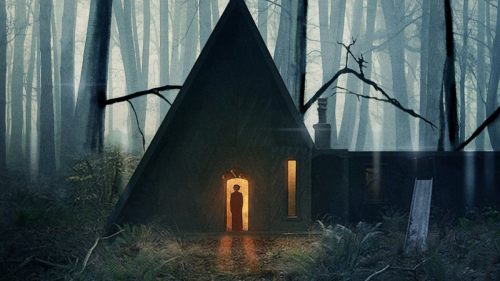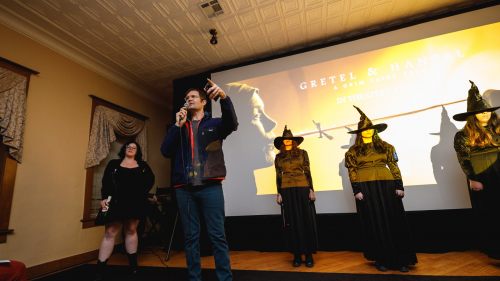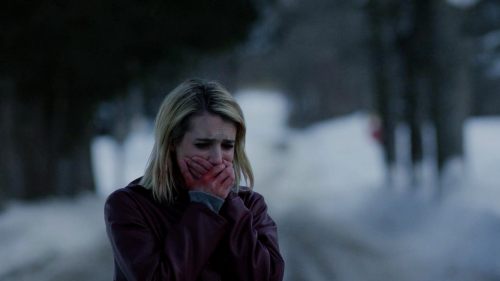When Women Come Of Age In Horror, It’s Magick
Gretel & Hansel is almost here. Get your tickets now!
The most effective horror movie villains are often unknowable – boogeymen, masked slashers, malevolent ghosts and ghouls. That fear of the unknown is magnified in films and stories that deal with witchcraft, which offers a tidy metaphorical conduit through which storytellers can explore a woman's rise to power. And few things have remained more terrifying throughout history than a powerful woman. The mass hysteria of the witch hunt era is rooted in the fear of a wisened woman; though the origins of the word "witch" are relatively unclear, many scholars have come to believe it is dervied from the English words "wit" and "wisdom." Throughout the course of history, men have desperately fought to maintain their oppressive hold over women: Domestication, the withholding of education and voting rights, shipping wives off to psychiatric facilities where they endured torture disguised as medical procedures to cure them of "hysteria" (read: emotions and opinions), burning women in droves at the stake, using the government to control the bodies and rights of women because we cannot be trusted to make these choices for ourselves. Whatever the means, the reasoning has always been the same – and the origins of man's compulsion to control women can be found in the deep-seated fear of an intelligent, educated woman who acts decisively.
For as long as men have tried to oppress women there have been stories about witches. The wart-ridden hags of folklore and fairytales were typically one-dimensional villains who cursed well-meaning families and/or their first-born offspring, consumed children with grotesque abandon, and made questionable soups in giant pots. They were unmarried (because who could ever) and lived alone in the woods, and while that actually sounds like a pleasant way to spend your twilight years, the witch seemed to serve as a cautionary tale for women; when men are educated they can do great things, but knowledge – as the story of Adam and Eve teaches us – turns to pure evil in women's hands. (That's clearly a willful misinterpreation of the Bible. Obviously, the real story is that Eve was tired of being hungry so she decided to eat something, and God punished Eve – and all women – by making her self-conscious about her body. And thus diet culture was born.)
As the centuries wore on, a more modern take on the witch emerged: She is a woman who discovers her own inner strength, her powers a metaphor for coming-of-age and burgeoning sexuality. Thus the witch became an allegory for the lives of young women who are misunderstood and have their magic (or potential) suppressed by concern-trolling men. Horror movies about witches tend to offer compelling feminist subtext (or text), and some of the most notable and profound of the genre are – perhaps not coincidentally – written and/or directed by men. Robert Eggers' The Witch depicts a young woman coming of age under the oppressive eye of her religious zealot parents in the 17th century; her growing womanhood is perceived as a threat to her mother and a sin in the eyes of God and her father (who may as well be one in the same). In the film's final moments, she relinquishes her soul to Satan in an act of defiant emancipation, and joins her sisters in the woods to dance naked and free.
Luca Guadagnino's audacious reimagining of Suspiria marries the witch metaphor with Jungian archetypes to cast a potent cinematic spell. Through ritualistic dance, Dakota Johnson's Susie Bannion finds a cathartic escape from the rigid sexual and religious oppression of her past, but she also discovers an immense inner power – one that is easily corrupted in the wrong hands, such as those of the dance academy's elusive Madame Markos. In ’90s fave The Craft, witchcraft allows four teen girls to vanquish the personal struggles that have rendered them insecure and made them outcasts at their Catholic high school. Andrew Fleming's film also explores how the corruptibility of that power – in some ways, the witchcraft subgenre is to girls what the superhero genre is to boys. A common thread in both genres is the responsibility that comes with supernatural ability; villains and heroes are two sides of the same coin, and merely having power does not make someone powerful – it's what they do with it. This gendered dichotomy between the two genres is glaring in a sort of humorous way.
The notion of women coming of age through the supernatural isn't confined to tales of witchcraft – Carrie and Ginger Snaps trek similar territory through telekinesis and lycanthropy, respectively, and The Blackcoat's Daughter (previously titled February) takes a more specific approach in its depiction of first heartbreak through a girl's relationship with the devil. The director of that film, Osgood Perkins, is also behind Gretel & Hansel, a reimagining of the classic Brothers Grimm folktale that – as the title implies – puts the emphasis on Gretel. Played by Sophia Lillis, Gretel is young girl on the verge of womanhood burdened with responsibilities no child should bear. Her parents are so impoverished that they can no longer care for Gretel and her younger brother Hansel, so she is forced out into the world to find a way to provide for them. Gretel has become wise beyond her years, but it's a painful sort of wisdom that she didn't ask for and which demands great sacrifice. As the familiar story goes, Gretel and Hansel stumble upon the home of a witch who has a bounty of food she's eager to share, only to discover they've been selected for the witch's next meal.
But Gretel & Hansel does something compelling with the folktale, which examines the burdens placed on women and the horrible sacrifices required to achieve some semblance of a life. In Perkins' telling, Gretel is a young woman confronted by the legacy of her gender and given the opportunity to recontextualize a terrifying nascent power; the antagonistic witch (Alice Krige) has a complex history which speaks to outdated feminism and the idea that there is limited space for women in the realm of men. Preempted by metatextual narration that addresses the nature of folklore itself and dressed with eerily evocative production design, Perkins' latest film is an effective thematic sibling to his prior efforts (including I Am the Pretty Thing That Lives in the House) and earns a rightful place among its witchy predecessors.



